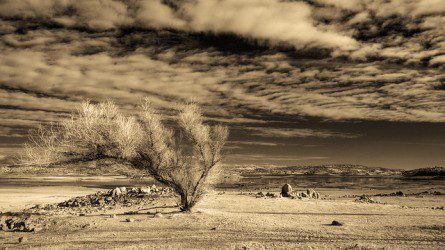
The conclusion with our chat with Gordon Mann, Matthew Fried and James Scheid about their tree care during the prolonged drought.
Do Western arborists in urban environments face different challenges than those in more rural areas?
GM: It depends. Some are on their own wells, and some are on the water system. So the challenges of the water system are going to be the same. A lot of farmers are saying “let’s pump the groundwater to get it through the town,” but if they deplete the groundwater we’re screwed anyhow.
Another thing with some rural areas that may have larger land space is that we see the native trees getting deep irrigation from the water tables. We’re thinking that once a lot of those water tables get depleted, then those trees will die. If the water table drops below 50 feet, those roots can’t get the water they need.
We’re also seeing some dieback now of pine due to lack of snow cover, and not getting the runoff from snow melt that they usually get. Some areas are using snow-makers and things like that to try and extend the snow cover for another 30 to 40 days, and it will be interesting to see if that has any impact.
What is one thing you’ve learned through this period of hardship?
MF: Really, that there is a lot of area for improvement in our infrastructure to capture and produce recycled water. In our city, we have an aging sewage treatment plant that while they produce something that’s cleaner than what went in, it’s not good enough for irrigation. It’s too high in chlorine and maybe salt, and there are other cities who I assume have newer technology. Just room for improvement with water recycling and using non-potable water to water plants.
I would love for our city to have a place I could go, hook up a fire hose, and pull out water that’s not drinkable and used to be sewage water but now waters trees perfectly. I would drive the truck around all day watering everything.
GM: A lot of times we can keep trees surviving and healthy through less-frequent, longer duration deep watering; soaking the water deep into the soil instead of just lawn water practice on residential landscapes.
JS: Trees react quickly to drought. We’ll go out and inspect newly planted trees and you can already see some dieback: leaves starting to curl, twigs starting to dry up, and you can feel it the soil. We have to be more vigilant than ever with watering. These new trees will react quickly and will have to deal with the shock of not only being transplanted, but the overall lack of water in general.
If people want to still see their trees thriving, they will have to water thema lot in the next few months.
What, if any, government support are arborists receiving?
MF: I know there are government programs, like Cal Water, that provide rebates for efficient irrigation equipment.
GM: In terms of support, we are working with the California Water Resource Board and the California Forest Advisory Council to get the messaging out that you want to water your trees during the drought.
Really its trying to get homeowners to look at the landscaping of their house. Get them to say “What is the hardest thing to replace, and the most long-term thing to replace.” Turf you can replace. Sod you can replace overnight. Most shrubs, you can plant them in a short amount of time and have them come back in a few years. But with your tree, it’s a 20 to 30 year replacement cycle. So if we budget our water, we could really focus on what’s most valuable and that’s a larger tree.
Has anything positive come out of the current situation – closer collaboration among city arborists, sharing of resources, planting of more native trees, etc?
MF: If there’s a silver lining, it’s that this shortage of water should make everyone more appreciative of water and more adamant about conserving the water. That will still benefit us even if the drought eases. It’s just like when fuel costs go up. All the sudden people are buying better cars. People are investing in better, more efficient irrigation equipment.
The irrigation companies out here are developing new stuff and holding seminars to tell people how to use it and what they can do to stay ahead of the regulations. I think anytime resources get scarce, people tighten their belts and they do more with less, and I hope that mentality will carry over even if the drought eases. We still don’t need to be blasting through potable water and can have a more efficient, sustainable infrastructure and program for using water for non-drinking purposes.
Is there anything else you would like to add?
GM: if we look at places like the Middle East where they have forests in the desert, they have watering systems that are very effective. We are learning to try and use some of those systems more and make ours better. The biggest thing we could do is figure out a better irrigation system a so we’ll have much more reliable water.

